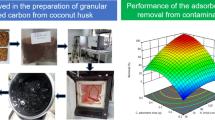Abstract
Granular activated carbon (GAC) has proven its effectiveness in removing radon from water supplies. Laboratory and pilot plant studies were carried out using three different types of activated carbons (F-300, F-400, and HD-4000) to remove radon from water supply. From the experimental kinetic study, the data indicated that at least 6 h are needed to attain equilibrium between radon activity adsorbed onto carbon and its concentration in the aqueous phase. Also, it showed that HD-4000 has higher capacity for removing radon than the other two investigated carbons F-300 and F-400. The adsorption isotherms were satisfactorily explained by Freundlich equation. In the pilot plant study, the performance of the three activated carbons in removing radon at medium concentration (~111 Bq dm−3) was evaluated over 60 days of continuous water flow. Four empty-bed contact times (EBCTs) corresponding to four bed depths were continuously monitored and the corresponding steady state adsorption-decay constant values were calculated and the efficiency of each carbon was used to provide a facet for comparison. The γ-radiation exposure rate distribution throughout each GAC bed was measured and compared. This study, despite paucity of literature in this field, is useful for designing a GAC adsorption system for the removal of medium level radon concentration from water supplies.



Similar content being viewed by others
References
Hess CT, Wiffenbach CV, Norton SA (1983) Environmental radon and cancer correlations in Maine. J Health Phys 45(2):339–348
Cross FT, Harley NH, Hofmann W (1985) Health effects and risks from Rn-222 in drinking water. J Health Phys 48(5):649–670
Mills WA (1990) Risk assessment and control management of radon in drinking water. In: Cothern CR, Rebers PA (eds) Radon, Radium and Uranium in drinking water. Lewis Publishers, Chelsea, pp 27–37
Crawford-Brown DJ (1990) Analysis of the health risk from ingested radon. In: Cothern CR, Rebers PA (eds) Radon, Radium and Uranium in drinking water. Lewis Publishers, Chelsea, pp 17–26
Crawford-Brown DJ (1992) Cancer risk from radon. J AWWA 84(3):77–81
Lowry JD, Moreau E (1986) Removal of extreme radon and uranium from a water supply. In: Proceedings of the ASCE national conference on environmental engineering, Cincinnati
Lowry JD, Brandow JE (1985) Removal of radon from water supplies. J Environ Eng 111(4):511–527
US Environmental Protection Agency (USEPA) (1991) National primary drinking water regulations; radionuclides; proposed rule. Fed Reg, vol 56, no 138, USA.
Pontius FW (2002) Regulatory compliance planning to ensure water supply safety. J AWWA 94(3):52–64
US Environmental Protection Agency (USEPA) (1990) Waste by-products document in support of drinking water treatment BAT cost analyses. Prepared by Malcolm Pirnie Inc. for Office of Drinking Water, USA
Alabdula’aly AI, Maghrawy HB (1999) Radon removal from water supplies by diffused bubble aeration system. J Radioanal Nucl Chem 241(1):3–9
Lowry JD, Brandow JE (1981) Removal of radon from groundwater supplies using granular activated carbon or diffused aeration. Research Technical Report, University of Maine, USA
Kinner NE, Jr Malley JP, Clement JA, Fox KR (1993) Using POE techniques to remove radon. J AWWA 85(6):75–86
Lowry JD, Lowry SB, Cline JK (1991) Radon removal by POE GAC systems: design, performance, and cost. EPA/600/52-90/049, Springfield, VA. National Technical Information Service, PB 91-125-633, AS, USA
STUK-A 169 (2000) Treatment techniques for removing natural radionuclides from drinking water. Helsinki, Finland, 101 pp
Lykins BW Jr, Clark RM, Goodrich JA (1992) Point-of-use/point-of-entry for drinking water treatment. Lewis Publishers, Chelsea
Markkanen M (2005) Technical guidance on safe installation of a GAC filter used for removing radon from water. Radioact Environ 7:665–669
Raucher RS, Drago J (1992) Estimating the cost of compliance with the drinking water standard for radon. J AWWA 84(3):51–65
Prichard HM, Gesell TF (1977) Rapid measurements of radon-222 concentration in water with a commercial liquid scintillation counter. J Health Phys 33(12):577–581
Snoeyink VL (1990) Adsorption of organic compounds. In: Pontius FW (ed) Water quality and treatment: a handbook of community water supplies, chap 13, 4th edn. American Water Works Association, McGraw-Hill, London, pp 781–875
Lowry JD, Brutsaert WF, Mcenerney T, Make C (1987) Point-of-entry removal of radon from drinking water. J AWWA 79(4):162–169
Reed DF (1989) Radon treatment for a Maine public water supply. SEA Consultants, Cambridge
Turtiainen T, Salonen L, Myllymaki P (2000) Radon removal from different types of groundwater applying granular activated carbon filtration. J Radioanal Nucl Chem 243(2):423–432
Salonen L (1994) Future groundwater resources at risk. In: Proceedings of the Helsinki conference. IAHS Publ. no. 222, p 71
Finnish Radiation and Nuclear Safety (1993) The radioactivity of household water. ST-Guide 12.3. Finnish Centre for Radiation and Nuclear Safety, Helsinki
Valentine RL, Stearns S, Kurt A, Walsh D, Mielke W (1992) Radon and radium from distribution system and filter media deposits. WQTC, Toronto, pp 15–19
Lowry JD, Lowry SB (1987) Modeling point-of-entry radon removal by GAG. J AWWA 79(10):85–88
Weber WJ Jr (1972) Physiochemical processes for water quality control. Wiley, New York
Snoeyink VL (1983) Control strategy—adsorption techniques; occurrence and removal of volatile organic chemical from drinking water. AWWA Cooperative Research Report, Denver, USA
Evans RD (1969) Engineer’s guide to the elementary behavior of radon daughters. J Health Phys 17(2):229–252
Rydell S, Keene B, Lowry J (1989) Granular activated carbon water treatment and potential radiation hazards. J NEWWA 103(4):234–248
Acknowledgments
The work reported has been funded by King Abdulaziz City for Science and Technology (KACST), Riyadh, Saudi Arabia whom the authors appreciate.
Author information
Authors and Affiliations
Corresponding author
Rights and permissions
About this article
Cite this article
Alabdula’aly, A.I., Maghrawy, H.B. Comparative study of different types of granular activated carbon in removing medium level radon from water. J Radioanal Nucl Chem 287, 77–85 (2011). https://doi.org/10.1007/s10967-010-0804-1
Received:
Published:
Issue Date:
DOI: https://doi.org/10.1007/s10967-010-0804-1




